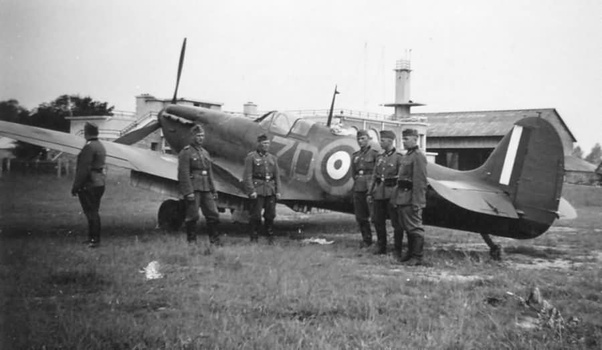During the Battle of Britain legend has it that when Head of the Nazi Luftwaffe, Hermann Goering asked Major Adolf Galland what was required to beat the British RAF, the Major told him ‘a squadron of Spitfires’.
This did not go down very well at the time, but it could have become a reality had the Germans capitalised on an opportunity that presented itself just a little while later.

On November 18th, 1942, Pilots Bernard Scheidhauer and Henri de Bordas of the Free French Air Force, based at the 131 Squadron Westhampnett, Kent were on a ‘rhubarb’ reconnaissance mission over the Normandy coast, looking for potential targets.
They had started out at Cherbourg and were following the road to Caen, making sure to avoid the heavy anti-aircraft batteries at Carentan.
There was a lot of flak in the sky, which made the mission particularly hazardous for both pilots, but this kind of mission was essential for planning bombing raids and keeping tabs on the German Army.
I love this story! How the Nazis crossbred a MesserSpit https://t.co/hD7p1iMqOw
— James Holland (@James1940) January 22, 2020
The two planes attacked several positions but over the small town of Ecausseville, Henri de Bordas lost contact with Scheidhauer. After some time spent circling the town trying to spot his partner de Bordas gave up and made for Kent.
Scheidhauer’s plane had been hit and had started to rapidly lose fuel. Disorientated and confused he headed West instead of North and, after crossing a body of water he spotted land and decided to make a forced landing, convinced he had arrived safely over the Isle of Wight.
In actual fact, his spectacular wheels-up landing in a turnip field was on the German-occupied island of Jersey near Dielament Manor, Trinity.
MesserSpit – The Case of Captured and Re-engined Spitfire EN830 – https://t.co/0fdYqr8JK0
Spitfire Vb (EN830/NX-X) fell into German hands late in 1942. On November 18th while being flown by P/O Bernard Sheidhauer of the Free French Air force, attached to 131 “County of Kent” S… pic.twitter.com/o1A5fT0Gy1— Aviation Humor (@AviationHumor) January 26, 2019
A small crowd of locals hurried to the crash site where they informed Scheidhauer of his navigational error.
In response he made every effort to destroy the plane, breaking the instrument panel, giving away equipment and even attempting to set fire to the aircraft, but by then all the fuel in the reservoirs had gone.
Twenty minutes later a German patrol picked up the pilot and eventually Scheidhauer was sent to Stalag Luft 111 where he was executed for his part in the mass break-out later dubbed ‘The Great Escape’.
The plane, a Mk V Spitfire Vb (EN830/NX-X), was dismantled and shipped to Echterdingen, Germany without its guns and ammunition.
The radio equipment was gone but it had retained its Merlin 45 engine. Daimler-Benz pilots made several flights in the reassembled plane before the decision was taken to experiment with it.
The plane was gutted and re-fitted with entirely new German standard 24-volt Luftwaffe electrics and instruments, a 3.0 m. diameter Bf.109G propeller and a carburettor scoop from a Bf.109G.
A Daimler-Benz engine from the same standard Messerschmidt provided the power and the Hybrid ‘Messer-Spit’ was born.
Luftwaffe Officer Ellenreider was the Messer-Spit’s first test pilot at Echterdingen. He reported better visibility and handling on the ground than the Bf.109 and that it needed a shorter runway for take-off.
Its climb rate was also outstanding at seventy feet per second (21m). While the Messerschmidt proved faster at low altitude at 11,000 feet things evened out with the Messer-spit achieving a higher ceiling than its half-sibling.
The hybrid plane was sent to Rechlin where test data was checked and verified before it was returned to Etcherdingen where it was used as an official testbed.
The Messer-Spit became a popular distraction for pilots who were keen to fly this adapted aircraft as much as possible, taking it into the air after normal shift duties had been completed.
Found: USS Grayback, Final Resting Place of 80 Entombed Sailors
On August 14th, 1944, US Bombers attacked the German airbase and the modified Spitfire was destroyed and the remains scrapped at the Klemm factory in Böblingen Meanwhile, back in Jersey, there remains a small part of the Spitfire’s original wooden prop and Scheidhauer’s flying helmet.
